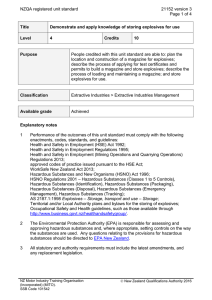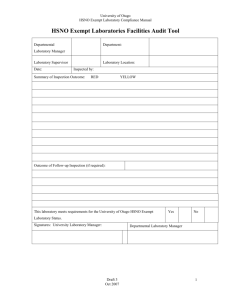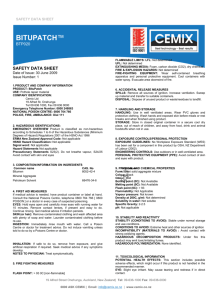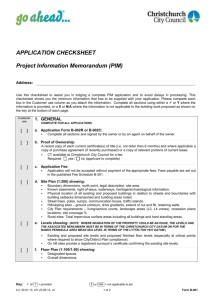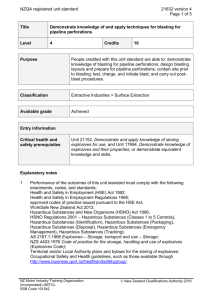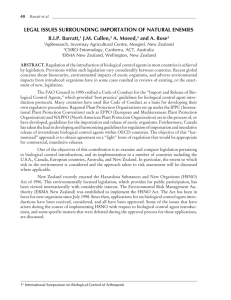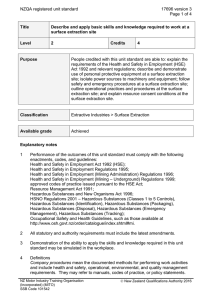NZQA registered unit standard 8918 version 7 Page 1 of 4
advertisement
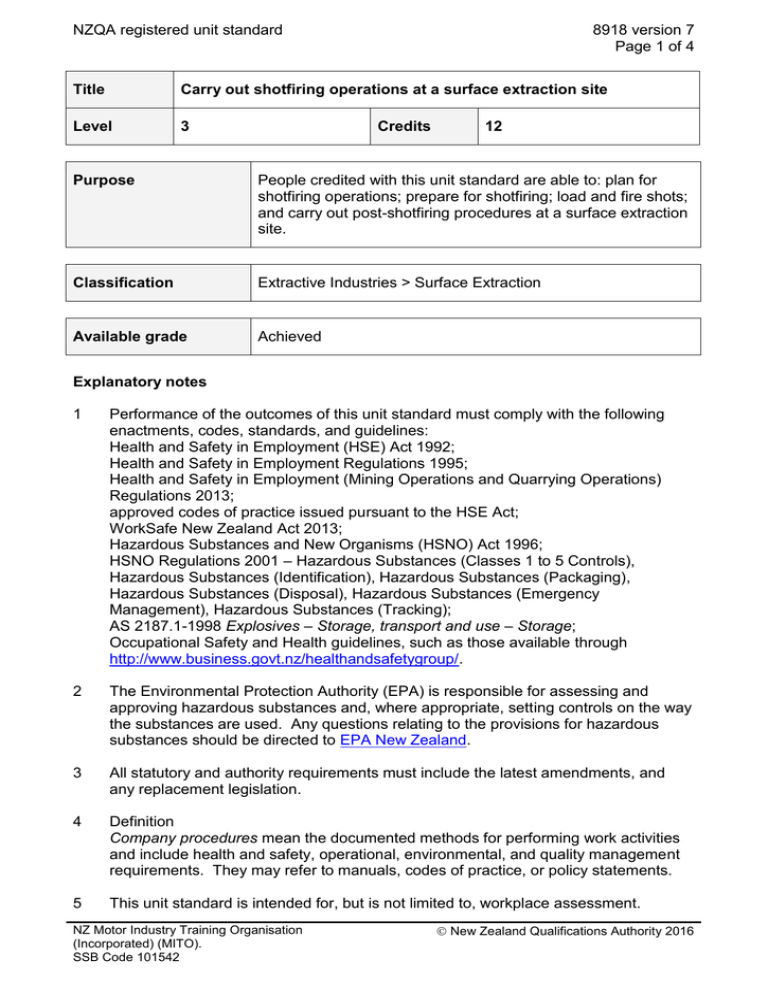
NZQA registered unit standard 8918 version 7 Page 1 of 4 Title Carry out shotfiring operations at a surface extraction site Level 3 Credits 12 Purpose People credited with this unit standard are able to: plan for shotfiring operations; prepare for shotfiring; load and fire shots; and carry out post-shotfiring procedures at a surface extraction site. Classification Extractive Industries > Surface Extraction Available grade Achieved Explanatory notes 1 Performance of the outcomes of this unit standard must comply with the following enactments, codes, standards, and guidelines: Health and Safety in Employment (HSE) Act 1992; Health and Safety in Employment Regulations 1995; Health and Safety in Employment (Mining Operations and Quarrying Operations) Regulations 2013; approved codes of practice issued pursuant to the HSE Act; WorkSafe New Zealand Act 2013; Hazardous Substances and New Organisms (HSNO) Act 1996; HSNO Regulations 2001 – Hazardous Substances (Classes 1 to 5 Controls), Hazardous Substances (Identification), Hazardous Substances (Packaging), Hazardous Substances (Disposal), Hazardous Substances (Emergency Management), Hazardous Substances (Tracking); AS 2187.1-1998 Explosives – Storage, transport and use – Storage; Occupational Safety and Health guidelines, such as those available through http://www.business.govt.nz/healthandsafetygroup/. 2 The Environmental Protection Authority (EPA) is responsible for assessing and approving hazardous substances and, where appropriate, setting controls on the way the substances are used. Any questions relating to the provisions for hazardous substances should be directed to EPA New Zealand. 3 All statutory and authority requirements must include the latest amendments, and any replacement legislation. 4 Definition Company procedures mean the documented methods for performing work activities and include health and safety, operational, environmental, and quality management requirements. They may refer to manuals, codes of practice, or policy statements. 5 This unit standard is intended for, but is not limited to, workplace assessment. NZ Motor Industry Training Organisation (Incorporated) (MITO). SSB Code 101542 New Zealand Qualifications Authority 2016 NZQA registered unit standard 8918 version 7 Page 2 of 4 6 The blast plan will be supplied to the candidate. 7 Joint assessment is required for this unit standard, which has been considered as critical by the NZ Motor Industry Training Organisation (Incorporated) (MITO) because of the high degree of risk. Please contact MITO for further information about the requirements of joint assessment. Outcomes and evidence requirements Outcome 1 Plan for shotfiring operations at a surface extraction site. Evidence requirements 1.1 Geological and/or survey data required to complete shotfiring operations is determined in accordance with company procedures. 1.2 Blast plan and specifications are inspected and implemented in accordance with company procedures. Range 1.3 revised drill pattern, equipment required, location, transport, safe storage, type and quantity of explosives and initiation methods, wet or dry holes, stemming material. Support requirements are co-ordinated in accordance with blast plan. Range includes – vehicles, site notification; may include – public notification. Outcome 2 Prepare for shotfiring at a surface extraction site. Evidence requirements 2.1 Blast site is prepared in accordance with blast plan, company procedures, and the HSNO Act 1996 and HSNO Regulations 2001. Range 2.2 includes – clean up, signage, hole identification, inspection, measuring holes; may include – fencing, de-watering holes. Explosives are prepared in accordance with blast plan, the HSNO Act 1996 and HSNO Regulations 2001, and company procedures. NZ Motor Industry Training Organisation (Incorporated) (MITO). SSB Code 101542 New Zealand Qualifications Authority 2016 NZQA registered unit standard 2.3 Blasting accessories are obtained and transported to site in accordance with blast plan and the HSNO Act 1996 and HSNO Regulations 2001 and company procedures. Range 2.4 8918 version 7 Page 3 of 4 may include but is not limited to – primers, delays, down lines, trunk lines, leading line, safety fuse, detonators, gas bags, stemming hole liner, blast monitoring system, exploders, electronic firing equipment. Safety procedures are implemented in accordance with the site safety plan, the HSNO Act and HSNO Regulations, and company procedures. Range may include but is not limited to – removal of tools from area, distance from other working areas, separation of drilling and blasting crews, charging poles, drill hole diameter, detonating cords, fencing, warning signs, hole identification, blast-hole cleaning, sounding, removal of personnel to a safe distance. Outcome 3 Load and fire shots at a surface extraction site. Evidence requirements 3.1 Shot holes are loaded in accordance with blast plan, the HSNO Act 1996 and HSNO Regulations 2001, and company procedures. Range may include – prime, load, stem. 3.2 Firing sequence is verified in accordance with blast plan. 3.3 Area is cleared and final safety procedures are implemented in accordance with the HSNO Act and HSNO Regulations, and company procedures. Range 3.4 warnings, shelter, entry, exits, blast guards, tag board. Shots are initiated in accordance with blast plan and the HSNO Act 1996 and HSNO Regulations 2001, and company procedures. Outcome 4 Carry out post-shotfiring procedures at a surface extraction site. Evidence requirements 4.1 Procedures for misfires, where required, are initiated and carried out in accordance with blast plan, company procedures, and the HSNO Act 1996 and HSNO Regulations 2001. 4.2 All clear signal is given in accordance with blast plan, company procedures, and the HSNO Act 1996 and HSNO Regulations 2001. NZ Motor Industry Training Organisation (Incorporated) (MITO). SSB Code 101542 New Zealand Qualifications Authority 2016 NZQA registered unit standard 4.3 8918 version 7 Page 4 of 4 Documentation is completed in accordance with blast plan, company procedures, and the HSNO Act 1996 and HSNO Regulations 2001. Planned review date 31 December 2017 Status information and last date for assessment for superseded versions Process Version Date Last Date for Assessment Registration 1 26 November 1996 31 December 2012 Revision 2 17 December 1996 31 December 2012 Revision 3 18 December 1998 31 December 2012 Review 4 19 April 2002 31 December 2012 Review 5 27 January 2005 31 December 2012 Review 6 18 March 2011 31 December 2017 Review 7 22 August 2014 N/A Consent and Moderation Requirements (CMR) reference 0114 This CMR can be accessed at http://www.nzqa.govt.nz/framework/search/index.do. Please note Providers must be granted consent to assess against standards (accredited) by NZQA, before they can report credits from assessment against unit standards or deliver courses of study leading to that assessment. Industry Training Organisations must be granted consent to assess against standards by NZQA before they can register credits from assessment against unit standards. Providers and Industry Training Organisations, which have been granted consent and which are assessing against unit standards must engage with the moderation system that applies to those standards. Requirements for consent to assess and an outline of the moderation system that applies to this standard are outlined in the Consent and Moderation Requirements (CMR). The CMR also includes useful information about special requirements for organisations wishing to develop education and training programmes, such as minimum qualifications for tutors and assessors, and special resource requirements. Comments on this unit standard Please contact the NZ Motor Industry Training Organisation (Incorporated) (MITO) info@mito.org.nz if you wish to suggest changes to the content of this unit standard. NZ Motor Industry Training Organisation (Incorporated) (MITO). SSB Code 101542 New Zealand Qualifications Authority 2016
